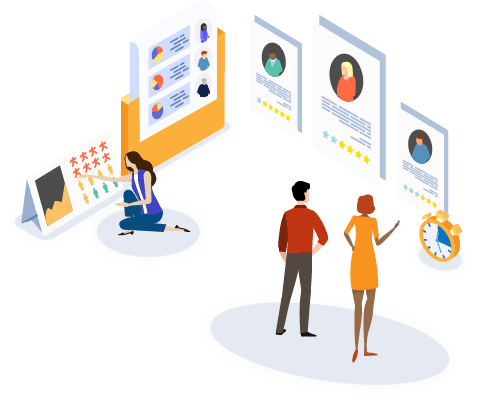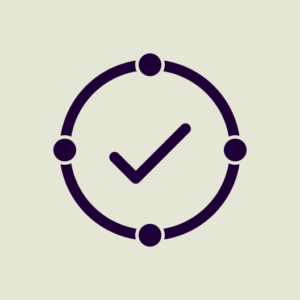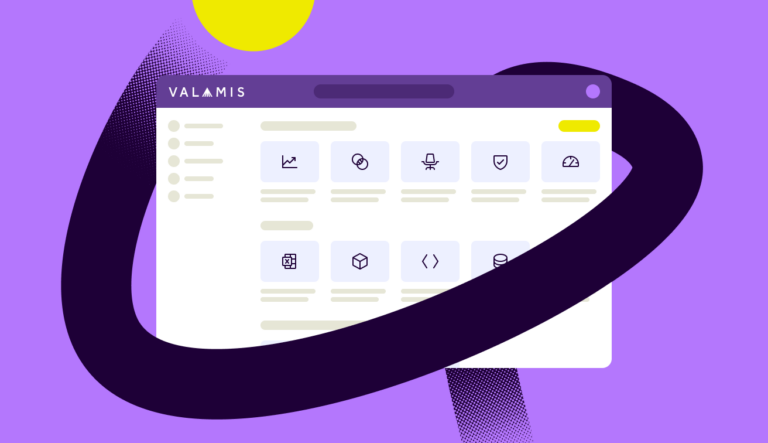Human Resource (HR) analytics
Learn what is HR analytics and how does it work. Discover examples, metrics and learn how it can be implemented and used in your organization.

Discover:
- What is HR analytics?
- Why is HR analytics needed?
- Examples in HR analytics
- How does HR analytics work?
- Examples of HR analytics metrics
- Pros and cons of HR analytics
- Predictive HR analytics
What is HR analytics?
HR analytics is the process of collecting and analyzing Human Resource (HR) data in order to improve an organization’s workforce performance. The process can also be referred to as talent analytics, people analytics, or even workforce analytics.
This method of data analysis takes data that is routinely collected by HR and correlates it to HR and organizational objectives. Doing so provides measured evidence of how HR initiatives are contributing to the organization’s goals and strategies.
For example, if a software engineering firm has high employee turnover, the company is not operating at a fully productive level.
It takes time and investment to bring employees up to a fully productive level.
HR analytics provides data-backed insight on what is working well and what is not so that organizations can make improvements and plan more effectively for the future.
As in the example above, knowing the cause of the firm’s high turnover can provide valuable insight into how it might be reduced. By reducing the turnover, the company can increase its revenue and productivity.
Read: How to Successfully Implement Learning Analytics in Your company
Why is HR analytics needed?

Most organizations already have data that is routinely collected, so why the need for a specialized form of analytics? Can HR not simply look at the data they already have?
Unfortunately, raw data on its own cannot actually provide any useful insight. It would be like looking at a large spreadsheet full of numbers and words.
Without organization or direction, the data appears meaningless.
Once organized, compared and analyzed, this raw data provides useful insight.
They can help answer questions like:
- What patterns can be revealed in employee turnover?
- How long does it take to hire employees?
- What amount of investment is needed to get employees up to a fully productive speed?
- Which of our employees are most likely to leave within the year?
- Are learning and development initiatives having an impact on employee performance?
Having data-backed evidence means that organizations can focus on making the necessary improvements and plan for future initiatives.
With the ability to answer important organizational questions without any guesswork, it is not surprising that many businesses using HR analytics are attributing performance improvement to HR initiatives.

Use learning data to accelerate change
Understand learning data and receive a practical tool to help apply this knowledge in your company.
Download workbookExamples in HR analytics
How can HR Analytics be used by organizations?
Let’s take a look at a few examples using common organizational issues:
1. Turnover
When employees quit, there is often no real understanding of why.
There may be collected reports or data on individual situations, but no way of knowing whether there is an overarching reason or trend for the turnover.
With turnover being costly in terms of lost time and profit, organizations need this insight to prevent turnover from becoming an on-going problem.
HR Analytics can:
- Collect and analyze past data on turnover to identify trends and patterns indicating why employees quit.
- Collect data on employee behavior, such as productivity and engagement, to better understand the status of current employees.
- Correlate both types of data to understand the factors that lead to turnover.
- Help create a predictive model to better track and flag employees who may fall into the identified pattern associated with employees that have quit.
- Develop strategies and make decisions that will improve the work environment and engagement levels.
- Identify patterns of employee engagement, employee satisfaction and performance.

Exit interview template
Conduct an exit interview and collect valuable information that can help improve the work culture in your organization.
Download Template2. Recruitment
Organizations are seeking candidates that not only have the right skills, but also the right attributes that match with the organization’s work culture and performance needs.
Sifting through hundreds or thousands of resumes and basing a recruitment decision on basic information is limiting, more so when potential candidates can be overlooked. For example, one company may discover that creativity is a better indicator of success than related work experience.
HR Analytics can:
- Enable fast, automated collection of candidate data from multiple sources.
- Gain deep insight into candidates by considering extensive variables, like developmental opportunities and cultural fit.
- Identify candidates with attributes that are comparable to the top-performing employees in the organization.
- Avoid habitual bias and ensure equal opportunity for all candidates; with a data-driven approach to recruiting, the viewpoint and opinion of one person can no longer impact the consideration of applicants.
- Provide metrics on how long it takes to hire for specific roles within the organization, enabling departments to be more prepared and informed when the need to hire arises.
- Provide historical data pertaining to periods of over-hiring and under-hiring, enabling organizations to develop better long-term hiring plans.

Onboarding checklist in PDF and Excel formats
Ensure a smooth and effective onboarding process for your new hires and set them up for success.
DownloadHow does HR analytics work?
Understanding the process of HR analytics
HR Analytics is made up of several components that feed into each other.
- To gain the problem-solving insights that HR Analytics promises, data must first be collected.
- The data then needs to be monitored and measured against other data, such as historical information, norms or averages.
- This helps identify trends or patterns. It is at this point that the results can be analyzed at the analytical stage.
- The final step is to apply insight to organizational decisions.
Let’s take a closer look at how the process works:
1. Collecting data
Big data refers to the large quantity of information that is collected and aggregated by HR for the purpose of analyzing and evaluating key HR practices, including recruitment, talent management, training, and performance.
Collecting and tracking high-quality data is the first vital component of HR analytics.
The data needs to be easily obtainable and capable of being integrated into a reporting system. The data can come from HR systems already in place, learning & development systems, or from new data-collecting methods like cloud-based systems, mobile devices and even wearable technology.
The system that collects the data also needs to be able to aggregate it, meaning that it should offer the ability to sort and organize the data for future analysis.
What kind of data is collected?
- employee profiles
- performance
- data on high-performers
- data on low-performers
- salary and promotion history
- demographic data
- on-boarding
- training
- engagement
- retention
- turnover
- absenteeism
2. Measurement
At the measurement stage, the data begins a process of continuous measurement and comparison, also known as HR metrics.
HR analytics compares collected data against historical norms and organizational standards. The process cannot rely on a single snapshot of data, but instead requires a continuous feed of data over time.
The data also needs a comparison baseline. For example, how does an organization know what is an acceptable absentee range if it is not first defined?
In HR analytics, key metrics that are monitored are:
Organizational performance
Data is collected and compared to better understand turnover, absenteeism, and recruitment outcomes.
Operations
Data is monitored to determine the effectiveness and efficiency of HR day-to-day procedures and initiatives.
Process optimization
This area combines data from both organizational performance and operations metrics in order to identify where improvements in process can be made.
Examples of HR analytics metrics
Here are some examples of specific metrics that can be measured by HR:
- Time to hire – The number of days that it takes to post jobs and finalize the hiring of candidates. This metric is monitored over time and is compared to the desired organizational rate.
- Recruitment cost to hire – The total cost involved with recruiting and hiring candidates. This metric is monitored over time to track the typical costs involved with recruiting specific types of candidates.
- Turnover – The rate at which employees quit their jobs after a given year of employment within the organization. This metric is monitored over time and is compared to the organization’s acceptable rate or goal.
- Absenteeism – The number of days and frequency that employees are away from their jobs. This metric is monitored over time and is compared to the organization’s acceptable rate or goal.
- Engagement rating – The measurement of employee productivity and employee satisfaction to gauge the level of engagement employees have in their job. This can be measured through surveys, performance assessments or productivity measures.
3. Analysis
The analytical stage reviews the results from metric reporting to identify trends and patterns that may have an organizational impact.
There are different analytical methods used, depending on the outcome desired. These include: descriptive analytics, prescriptive analytics, and predictive analytics.
Descriptive Analytics is focused solely on understanding historical data and what can be improved.
Predictive Analytics uses statistical models to analyze historical data in order to forecast future risks or opportunities.
Prescriptive Analytics takes Predictive Analytics a step further and predicts consequences for forecasted outcomes.
Examples of analytics:
Here are some examples of metrics at the analytics stage:
- Time to hire – The amount of time between a job posting and the actual hire is a metric that enables HR to gain insight into the efficiency of the hiring process; it prompts investigation into what is working and what is not working. Does it take too long to find the right candidate? What factors could be impacting the result?
- Turnover – Turnover metrics that indicate the rate at which employees leave the organization after hire can be analyzed to determine what specific departments within the organization are struggling with retention and the possible factors involved, such as work environment dissatisfaction or lack of training support.
- Absenteeism – The metric indicating how often and how long employees are away from their jobs as compared to the organization’s established norm could be an indicator of employee engagement. As absenteeism can be costly to the productivity of an organization, the metric enables HR to investigate the possible reasons for high absence rates.
4. Application
Once metrics are analyzed, the findings are used as actionable insight for organizational decision-making.
Examples of how to apply HR analytics insights:
Here are some examples of how to apply the analysis gained from HR analytics to decision-making:
- Time to hire – If findings determine that the time to hire is taking too long and the job application itself is discovered to be the barrier, organizations can make an informed decision about how to improve the effectiveness and accessibility of the job application procedure.
- Turnover – Understanding why employees leave the organization means that decisions can be made to prevent or reduce turnover from happening in the first place. If lack of training support was identified as a contributing factor, then initiatives to improve on-going training can be put together.
- Absenteeism – Understanding the reasons for employee long-term absence enables organizations to develop strategies to improve the factors in the work environment impacting employee engagement.
Pros and cons of HR analytics
HR analytics is fast becoming a desired addition to HR practices.
Data that is routinely collected across the organization offers no value without aggregation and analysis, making HR analytics a valuable tool for measured insight that previously did not exist.
But while HR analytics offers to move HR practice from the operational level to the strategic level, it is not without its challenges.
Here are the pros and cons of implementing HR analytics:
Pros:
- More accurate decision-making can be had thanks to a data-driven approach, which reduces the need for organizations to rely on intuition or guess-work in decision-making.
- Strategies to improve retention can be developed thanks to a deeper understanding of the reasons employees leave or stay with an organization.
- Employee engagement can be improved by analyzing data about employee behavior, such as how they work with co-workers and customers, and determining how processes and environment can be fine-tuned.
- Recruitment and hiring can be better tailored to the organization’s actual skillset needs by analyzing and comparing the data of current employees and potential candidates.
- Trends and patterns in HR data can lend itself to forecasting via predictive analytics, enabling organizations to be proactive in maintaining a productive workforce.
Cons:
- Many HR departments lack the statistical and analytical skillset to work with large datasets.
- Different management and reporting systems within the organization can make it difficult to aggregate and compare data.
- Access to quality data can be an issue for some organizations who do not have up-to-date systems.
- Organizations need access to good quality analytical and reporting software that can utilize the data collected.
- Monitoring and collecting a greater amount of data with new technologies (eg. cloud-based systems, wearable devices), as well as basing predictions on data, can create ethical issues.

Use learning data to accelerate change
Understand learning data and receive a practical tool to help apply this knowledge in your company.
Download workbookPredictive HR analytics
Predictive Analytics analyzes historical data in order to forecast the future. The differentiator is the way data is used.
In standard HR analytics, data is collected and analyzed to report on what is working and what needs improvement. In predictive analytics, data is also collected but is used to make future predictions about employees or HR initiatives.
This can include anything from predicting which candidates would be more successful in the organization, to who is at risk of quitting within a year.
How does it work?
Advanced statistical techniques are used to create algorithmic models capable of identifying trends and future behaviors. These future trends can describe possible risks or opportunities that organizations can leverage in long-term decision-making.
Predictive HR examples
Let’s take a look at how predictive analytics can be used:
Turnover
With predictive analytics, an algorithm can be devised to predict the likelihood of employees quitting within a given timeframe. Being able to flag which employees are at risk enables organizations to step in with preventative measures and avoid the cost of losing productivity and the cost of re-hiring.
Organizational Performance
Historical data can pinpoint reasons for poor performance, but predictive analytics can make predictions about what initiatives are most likely to improve performance. If engagement levels are identified as being correlated with performance, then organizations can implement specific initiatives that boost employee engagement.
The benefits and challenges of predictive HR analytics
Benefits: Predictive HR analytics enables organizations to become proactive in their use of data.
Instead of fixing past problems, organizations can create a future that prevents problems and solves future challenges before they even happen. This can save on future costs, both in revenue, goals, and productivity.
Challenges: Predictive HR analytics requires a level of skill, technology and investment that many organizations do not yet have.
Many factors also need to be taken into consideration in order to make predictions about employees or potential candidates.
Human beings can be unpredictable and have different personalities, backgrounds and experiences. Slotting people into a black and white algorithm in order to make predictions about their job performance or future poses not just a risk, but an ethical question.

Use learning data to accelerate change
Understand learning data and receive a practical tool to help apply this knowledge in your company.
Download workbook



